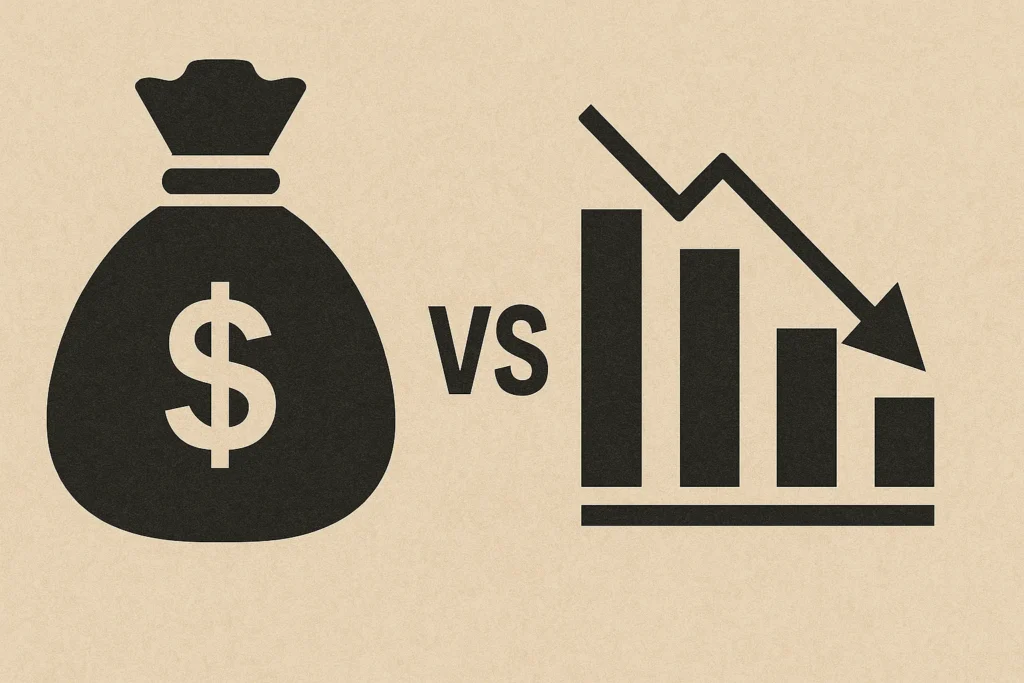Navigating the world of economics can often feel like deciphering a complex code. Two terms that frequently appear in headlines and political debates are “public debt” and “budget deficit.” While often used interchangeably, they represent distinct, yet related, aspects of a nation’s financial health. Understanding the difference is crucial for every informed citizen.
At its core, the distinction is simple: a budget deficit is a shortfall in a single year, while public debt is the accumulation of those shortfalls over many years.
Public Debt vs. Budget Deficit: A Beginner’s Guide
Many people confuse public debt and budget deficits. While related, they are distinct concepts with different implications. Let’s clarify the difference.
What is a Budget Deficit?
A budget deficit occurs when a government spends more money than it brings in through revenue during a specific period, usually a fiscal year. Think of it like spending more than you earn in a month.
The government might be funding various programs, such as infrastructure projects, social security, or defense. If these expenses exceed tax revenues and other income, a deficit arises.
What is Public Debt?
Public debt, on the other hand, is the accumulation of all past budget deficits plus any accumulated budget surpluses. It’s the total amount of money that a government owes to its creditors.
Imagine adding up all the times you’ve overspent and borrowed money – that’s essentially the public debt. This debt can be held internally (owed to citizens and institutions within the country) or externally (owed to foreign entities).
Key Differences Between Public Debt and Budget Deficit

Understanding the nuances between these two is essential. Here’s a breakdown of the key differences:
- Timeframe: A budget deficit is a snapshot in time, usually a year. Public debt is a cumulative total over many years.
- Nature: A budget deficit is a shortfall in revenue compared to spending. Public debt is the total amount owed.
- Impact: Budget deficits contribute to the growth of public debt. Public debt represents the overall financial burden on a nation.
How Budget Deficits Contribute to Public Debt
Each time a government runs a budget deficit, it needs to borrow money to cover the shortfall. This borrowing adds to the existing public debt. Think of it like this:
- The government spends more than it earns (budget deficit).
- To cover the difference, it issues bonds or other forms of debt.
- These bonds are purchased by investors, both domestic and foreign.
- The money raised from these bonds covers the deficit, but it also increases the total amount of public debt.
Over time, persistent budget deficits lead to a significant increase in public debt.
Factors Influencing Budget Deficits
Several factors can contribute to a budget deficit. These include:
Economic Downturns
During recessions, government revenues typically decrease as people lose jobs and businesses struggle. At the same time, government spending on unemployment benefits and other social safety nets often increases.
This combination of lower revenue and higher spending can lead to larger budget deficits.
Government Spending Policies
Increased government spending on infrastructure, defense, or social programs can also contribute to deficits. These policies might be necessary for economic growth or social welfare, but they can strain the budget if not offset by increased revenue.
Tax Policies
Tax cuts can stimulate the economy, but they also reduce government revenue. If spending remains constant, tax cuts can lead to larger budget deficits. The impact of tax policy on deficits is a subject of ongoing debate among economists.
Unforeseen Events
Unexpected events like natural disasters or pandemics can require significant government spending, leading to budget deficits. These events are often difficult to predict and can disrupt long-term budget planning.
Factors Influencing Public Debt
Several factors influence the accumulation of public debt. These include:
Persistent Budget Deficits
As mentioned earlier, consistent budget deficits are the primary driver of public debt. Each year the government spends more than it takes in, the debt grows.
Interest Rates
The interest rate on government debt plays a significant role in its growth. Higher interest rates mean the government has to pay more to service its debt, which can further increase the debt.
Economic Growth
Slower economic growth can make it more difficult for a government to manage its debt. A sluggish economy may lead to lower tax revenues, making it harder to reduce the budget deficit and ultimately the public debt.
Debt Management Strategies
The way a government manages its debt can also affect its overall level. Strategies like refinancing debt at lower interest rates or extending the maturity of debt can help to control debt growth.
The Impact of Public Debt and Budget Deficits
Both public debt and budget deficits can have significant impacts on a nation’s economy.
Economic Growth
High levels of public debt can crowd out private investment, as governments compete with businesses for funds. This can slow economic growth.
Budget deficits can sometimes stimulate the economy in the short term, but persistent deficits can lead to long-term economic instability.
Interest Rates
Large public debt can lead to higher interest rates, as lenders demand a premium to compensate for the risk of lending to a heavily indebted government. This can increase borrowing costs for businesses and consumers.
Inflation
If a government finances its budget deficits by printing money, it can lead to inflation. This devalues the currency and reduces purchasing power.
Future Generations
High levels of public debt can burden future generations with higher taxes and reduced government services. This is because future taxpayers will have to pay off the debt incurred today.
International Relations
Countries with high levels of public debt may be more vulnerable to economic and political pressure from international creditors. This can limit a country’s sovereignty and independence.
Managing Public Debt and Budget Deficits
Governments employ various strategies to manage public debt and budget deficits.
Fiscal Policy

Fiscal policy involves adjusting government spending and taxation to influence the economy. This can include measures like raising taxes, cutting spending, or implementing stimulus packages.
Monetary Policy
Monetary policy involves managing the money supply and interest rates to influence the economy. This is typically done by a central bank, such as the Federal Reserve in the United States.
Debt Management Strategies
Debt management strategies include refinancing debt at lower interest rates, extending the maturity of debt, and issuing inflation-indexed bonds.
Structural Reforms
Structural reforms involve making changes to the economy to improve its efficiency and competitiveness. This can include measures like deregulation, privatization, and labor market reforms.
Examples of Public Debt and Budget Deficits
To illustrate these concepts, let’s look at some examples.
The United States
The United States has a substantial public debt, accumulated over decades of budget deficits. Factors contributing to this include wars, economic downturns, and tax cuts.
The U.S. government uses a variety of strategies to manage its debt, including issuing Treasury bonds and bills.
Greece
During the European debt crisis, Greece experienced severe budget deficits and a rapidly growing public debt. This led to a financial crisis and required international bailouts.
Greece implemented austerity measures, including spending cuts and tax increases, to try to reduce its debt.
Japan
Japan has one of the highest levels of public debt in the world, largely due to its aging population and prolonged economic stagnation.
The Japanese government has used monetary policy and fiscal stimulus to try to boost its economy and manage its debt.
Public Debt vs. Budget Deficit: Why Should You Care?
Understanding public debt and budget deficits is important for several reasons:
- Economic Impact: These factors can affect economic growth, interest rates, and inflation, all of which can impact your personal finances.
- Government Policies: Understanding these concepts can help you make informed decisions about government policies and hold elected officials accountable.
- Future Generations: High levels of public debt can burden future generations with higher taxes and reduced government services.
- Investment Decisions: Public debt and budget deficits can affect investment decisions, as they can impact the value of stocks, bonds, and other assets.
Conclusion
Public debt and budget deficits are complex but crucial concepts for understanding how governments manage their finances. A budget deficit is a yearly shortfall, while public debt is the accumulation of these deficits over time. Both impact economic growth, interest rates, and future generations.
Understanding these concepts empowers you to make informed decisions about economic policies and their impact on your life. What are your thoughts on managing public debt? Share your insights!